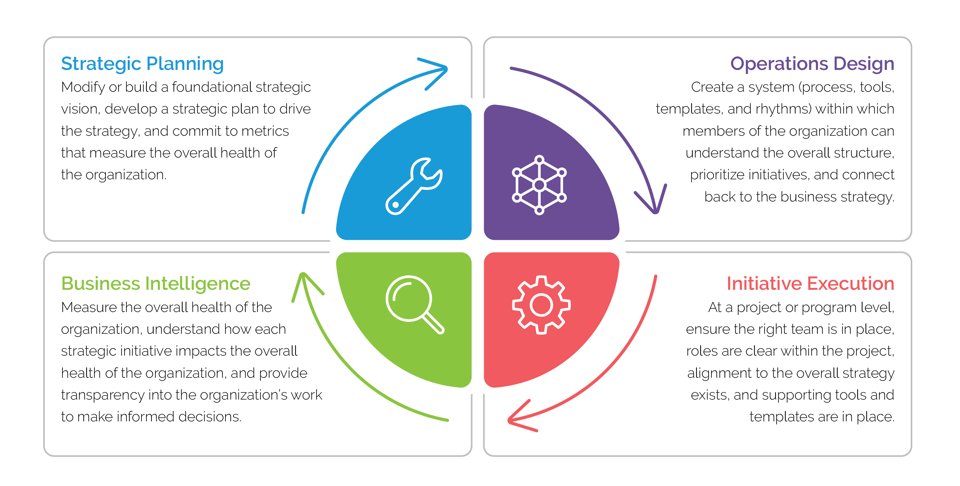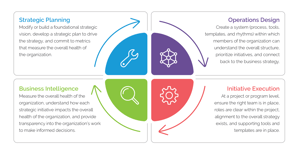All organizations, regardless of industry, size, or maturity, have a set of foundational activities required to run the business — often called business operations.
Successfully managing your business' operations strategy requires juggling many moving parts across multiple groups — with limited time and resources. You need diligent maintenance, well-informed strategic planning, and disciplined execution to succeed.
Almost always, one of two things causes failure: bad strategy or ineffective implementation.
Execution without strategy is chaos. You'll want to start with setting your strategy and establishing targets at regular intervals.
Then, you'll have the resources to develop and maintain effective operations. Finally, ensure you have the right team in place to prioritize, support, and execute strategic initiatives. Those initiatives will help drive your strategy and overall success.
When executed well, these practices allow your teams to focus on more important initiatives. At Spur Reply, we are fond of saying: “effective operations make the small things easy, so the big things become possible.”
The elements of a business operations framework
This is the first in a 5-part blog series defining Spur Reply’s unique perspective on the often overlooked, but incredibly valuable world of operations.
Part 1: This blog will focus on an overview of each part of business operations
Part 2: Strategic planning
Part 3: Operations design
Part 4: Initiative execution
Part 5: Business intelligence
We believe you should approach your operations within a proven framework. When you address all elements of the framework, your organization can fully reach its potential. Our framework demonstrates how strategic planning, operations design, initiative execution, and business intelligence relate to, influence, and depend on each other.

Strategic planning
Improving efficiency starts with strategic planning. Strategic planning is a critical component of any successful business operations framework. It involves setting clear goals and developing a roadmap for how you will achieve them.
The biggest challenge we see within business operations is a lack of alignment between initiatives and strategy. By aligning your strategic plan with your overall business objectives, you can ensure that every decision and action taken within your organization is moving you closer to your desired outcomes. Effective strategic planning also involves regularly reviewing and adjusting your plan based on changing market conditions, customer feedback, and internal performance metrics.
Often, setting a strategic plan can be overwhelming or a lower priority for leaders focused on deadlines. Ignoring your strategic plan can be expensive and lead to problems later on. Your plan will allow you to set goals that will lead to your future success.
A strong strategic plan is key to:
- Positioning the organization for success with the right investments
- Uniting the team under a single purpose
- Forming adequate resource allocation
- Measuring performance
- Ensuring alignment across the company
Strategic planning starts with identifying an organizational vision, mission, and set of objectives. We often advise our clients to set goals using objectives and key results (OKRs).
Then, define your approach and tactics to drive success. To truly harness the potential of a comprehensive business operations framework, your approach should prioritize agility and adaptability. In our current business landscape, the ability to quickly pivot in response to changing market dynamics is paramount. By embracing a culture of continuous improvement, businesses can stay ahead of the curve and maintain a competitive edge.
Lastly, ensure your strategy has an initiative selection and prioritization process that ensures you use resources the best way possible. You will then need to commit to a set of metrics, likely with key performance indicators (KPIs), to determine success and the overall health of your organization.
Operations design
Operations design establishes an organization's systems, processes, rhythms, and templates used to run their business on a daily basis. An operations ecosystem provides the right set of tools for completing work and produces useful, actionable information for leadership.
You’re creating the environment for your team — so getting it right is important.
A well-designed operations environment can streamline your team’s workload, allowing you to focus on important things — like enacting your strategy. A poorly designed environment can have huge negative impacts on team morale and ultimately your business. Research shows 42 percent of surveyed employees have searched for a new job because of poor operations management. Further, 15 percent of those workers eventually quit.
Our experience shows many leaders deprioritize operations so they can execute plans faster. This is a mistake — cutting corners will always catch up with you. A thoughtful design will inevitably lead to better execution and poor design to significant inefficiencies.
Initiative execution
Initiative execution is vital because it is where the rubber meets the road. You need the right teams and plans in place to bring your strategy to life.
Without the right team — either size or expertise — strategic initiatives can fail to meet their objectives. If your teams do not have the right tools, they can become disorganized or bogged down by simple tasks.
A key part of initiative execution is understanding how each task relates to others within the larger strategy. This ensures strategic initiatives stay on track, are well organized, and deliver the best results.
Spur Reply’s approach is to optimize within an initiative’s plan of record. By ensuring strategic initiatives are well organized and within the design parameters, we can identify gaps to improve the next project. Strong initiative execution is only possible through effective strategic planning and operational design.
Business intelligence
The fourth element of the business operations framework is business intelligence. It's essential to adopt a holistic approach that incorporates technology into every facet of your organizational functionality. Integrating advantageous technological solutions will help streamline processes, enhance collaboration, and drive innovation. From cloud-based project management platforms to AI-driven analytics tools, there is no shortage of ways to use technology for operations optimization.
When considering business intelligence as a part of business operations strategy, our focus is to create necessary tools to measure each project’s impact on the organization’s overall health. The metrics and views you develop should be able to effectively inform business decisions. To pull in new data, the reports also need to be easy to use.
Each initiative should be measurable and benchmarked against other initiatives. Further, the impact of the collective initiatives should be measured against metrics created during strategic planning. The measures should then inform updates, modifications, or redesigns of your organization’s strategy. Business intelligence completes the business operations cycle, from execution to strategy.
By measuring how each element of your operations is performing, you identify opportunities for improvement. Business intelligence also helps an organization predict how future projects might impact their business. Modeling and forecasting allow for future looking business intelligence, which is equally valuable as looking back at performance.
There is an almost infinite amount of data that modern businesses can collect and understanding that information is invaluable. Good business intelligence uses data analysis to measure the impact of initiatives, your organization's health, and demystifies key decisions.
Driving operational success
When considering how to manage your business operations, always consider how your actions will deliver value to your customers, partners, and stakeholders. Further, organizations can achieve their business goals by aligning operational strategies with their business objectives and customer needs. Prioritizing customer-centricity fosters loyalty, satisfaction, and long-term business growth, driving operational success in the process.
By embracing a comprehensive business operations framework, organizations can optimize efficiency, easily improve their products and services, drive innovation, and achieve operational efficiency. Streamlining operations is a symphony of strategy, systems, execution, and intelligence that makes your organization run. Ensuring that each element is in place will bring harmony to your organization and allow it to perform optimally.
Our next blog post will explore the importance of strategic planning in more detail and provide practical tips for creating a successful strategic plan.
Stay tuned for the next blogs in the series:
Part 2: Strategic planning
Part 3: Operations design
Part 4: Initiative execution
Part 5: Business intelligence



